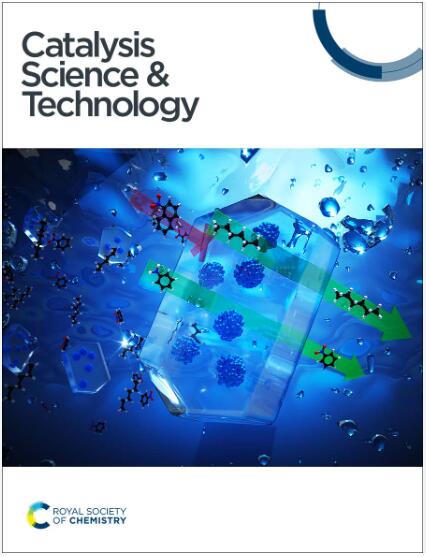Toward decorrelation of surface oxygen groups from metal dispersion effects in Pd/C hydrogenation catalysts†
IF 4.4
3区 化学
Q2 CHEMISTRY, PHYSICAL
引用次数: 0
Abstract
Carbon-supported Pd-based catalysts have found wide applications in hydrogenation of specific functional groups. Surface modification of the support, via the introduction of oxygen functional groups, modulates the metal dispersion and the interaction of reactant(s) with the catalyst surface, consequently tuning its catalytic properties. However, it is difficult to decorrelate the effect of surface oxygen groups from that of the dispersion of the metallic phase. This study aims at decorrelating these effects on the catalytic performance for phenylacetylene hydrogenation by using preformed monodispersed Pd nanoparticles deposited on carbon supports presenting different densities of surface oxygen groups. X-ray photoelectron spectroscopy, temperature-programmed decomposition experiments and transmission electron microscopy were used to analyze the dispersion and oxidation state of Pd and the concentration of surface oxygen groups. The results reveal that such decorrelation is not an easy task, particularly since spillover of the nanoparticles' native capping ligand (oleylamine) occurs during Pd particle deposition. This phenomenon, which depends on the density of oxygen functional groups and the size of Pd particles, impacts the Pd(0)/Pd2+ ratio and the surface Pd/N atomic ratio. These two last parameters, which seem to be interconnected, significantly impact the catalytic performance.

钯/碳加氢催化剂中金属分散效应对表面氧基的解相关研究
碳负载的钯基催化剂在特定官能团的加氢反应中有着广泛的应用。载体的表面改性,通过引入氧官能团,调节金属分散和反应物与催化剂表面的相互作用,从而调整其催化性能。然而,很难将表面氧基团的影响与金属相分散的影响分开。本研究旨在通过在碳载体上沉积具有不同表面氧基密度的预成型单分散钯纳米粒子来解除这些对苯乙炔加氢催化性能的影响。利用x射线光电子能谱、程序升温分解实验和透射电镜分析了钯的分散、氧化态和表面氧基的浓度。结果表明,这种去相关并不是一件容易的事情,特别是在Pd颗粒沉积过程中,纳米颗粒的天然盖层配体(油胺)会发生溢出。这种现象与氧官能团的密度和Pd粒子的大小有关,影响Pd(0)/Pd2+比和表面Pd/N原子比。这最后两个参数似乎是相互关联的,它们显著影响催化性能。
本文章由计算机程序翻译,如有差异,请以英文原文为准。
求助全文
约1分钟内获得全文
求助全文
来源期刊

Catalysis Science & Technology
CHEMISTRY, PHYSICAL-
CiteScore
8.70
自引率
6.00%
发文量
587
审稿时长
1.5 months
期刊介绍:
A multidisciplinary journal focusing on cutting edge research across all fundamental science and technological aspects of catalysis.
Editor-in-chief: Bert Weckhuysen
Impact factor: 5.0
Time to first decision (peer reviewed only): 31 days
 求助内容:
求助内容: 应助结果提醒方式:
应助结果提醒方式:


